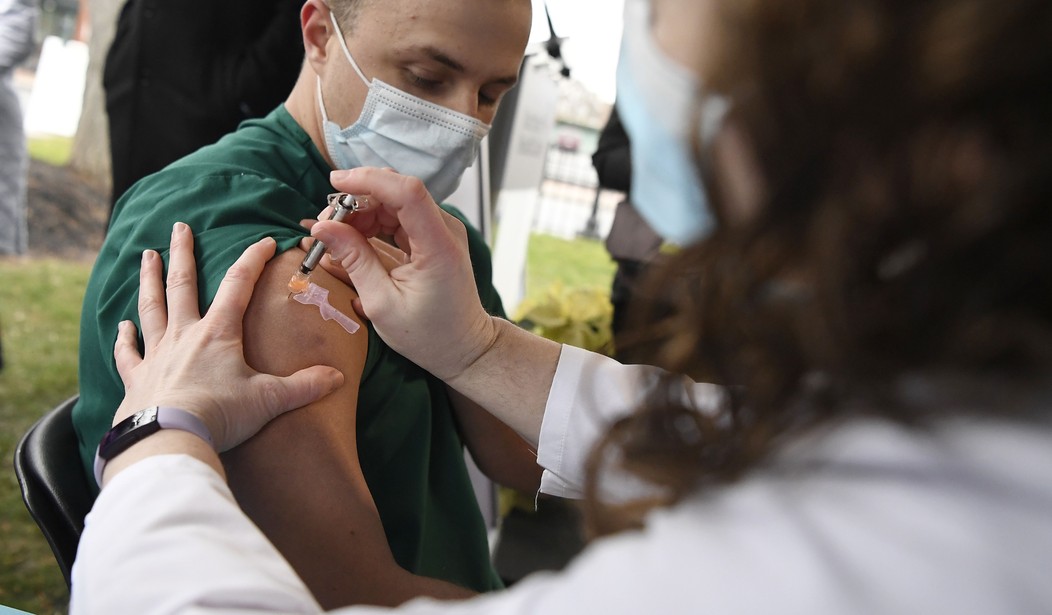The Johnson and Johnson COVID-19 vaccine has demonstrated exceptional efficacy against severe illness and death from the virus. This morning the FDA decided to pause using the vaccine because of a rare but severe form of blood clot experienced by a minimal number of individuals:
As of 4/12, 6.8m+ doses of the J&J vaccine have been administered in the U.S. CDC & FDA are reviewing data involving 6 reported U.S. cases of a rare & severe type of blood clot in individuals after receiving the vaccine. Right now, these adverse events appear to be extremely rare
— U.S. FDA (@US_FDA) April 13, 2021
So, why this is happening is a legitimate question. All COVID-19 vaccines used in the United States have Emergency Use Authorizations (EUAs). This designation means the companies that make them have demonstrated efficacy in studies that prove the vaccines work as intended in preventing infection or severe disease and death from COVID-19. Full FDA approval also requires safety studies. These studies, which account for the longer complete approval process, have not been conducted.
Before you freak out, the clinical trials were robust enough to detect safety issues that would affect a large portion of the population. The participants in those studies were volunteers and operated under informed consent about the risks of participation. Authorizing use in this manner amid a pandemic with a clearly identified group of high-risk patients was prudent of the FDA.
Those over 65 or suffering from morbid obesity, diabetes, or other preexisting conditions associated with severe illness and mortality from COVID-19 could be assured from the efficacy trials that their risk from the vaccine was lower than the risk from a COVID-19 disease on a population basis. With informed consent, encouraging vaccination in these individuals is both ethical and indicated.
Now that this potential side-effect has been identified, the overreach of recommending vaccination for all should pause. The encouragement of COVID-19 vaccination at all costs for everyone, especially children, needs to stop:
The Centers for Disease Control and Prevention and the Food and Drug Administration announced that they were investigating unusual clots that occurred 6 to 13 days after vaccination. The FDA commissioner said she expected the pause to last a matter of days.
The clots occurred in veins that drain blood from the brain and occurred together with low platelets, the fragments in blood that normally form clots. All six cases were in women between the ages of 18 and 48. One person died, and all of the cases remain under investigation.
Widespread vaccine implementation has provided insight into the vaccines’ potential risks that safety testing by the FDA would have taken years to uncover. Safety studies do not involve millions of participants, and 6.8 million Americans have received the Johnson and Johnson vaccine. This information is a blessing because the agencies can now do their due diligence, which should take a matter of days.
Additional caution is especially warranted since the Astra-Zeneca vaccine, which uses the same adenovirus platform, had the same side effect. In 25 million vaccines, there were 86 reports of clots and 18 deaths. Again, they occurred only in women in the pre-menopausal population. The question needs to be what these women have in common, and if that takes more than a few days, so be it.
Hooman Noorchashm, M.D., Ph.D., has warned of the possibility of a harmed minority in the public health bureaucracy’s rush to vaccination. He is not an anti-vaxxer by any means and has received the COVID-19 vaccination himself. So have his elderly parents. However, his wife died due to a procedure where she was one of a minority of women to develop cancer after a gynecological procedure.
These women all had cancer that was difficult to detect before the procedure and the method used caused it to spread quickly. Adverse event monitoring did not pick up this commonality in one out of 350 women having the procedure for years. It was activism by Noorchashm and his late wife, Dr. Amy Reed, that brought this information to the government’s attention. Noorchashm is acutely aware of the health bureaucracy’s willingness to ignore the harmed minority in favor of the majority who benefit from treatment.
This willingness is evident in a statement from the WHO regarding the Astra Zeneca vaccine. They claim to have analyzed 190 million doses globally and found 182 reports of clots. It’s critical to note the variation in post-vaccine monitoring systems worldwide, so there is no assurance this number is complete. However, following their analysis, the agency said: “If there is a causal link, the events are very rare and the risk is extremely low,”
For 19 women we know of, it was a deadly risk, and that is undoubtedly an underestimate. There were no cases in women over 60 identified, which is excellent news. It appears safe to administer these vaccines to the most at-risk individuals.
However, an investigative reporter, Heidi Hatch in Utah, looked at the efficacy of the CDC’s adverse event system. She uncovered the weaknesses in the CDC’s Vaccine Adverse Event Reporting System (VARES). Developed in 1990, most Americans don’t know it exists, and it is not clear who should be reporting post-vaccine issues. The New York Times concurred:
For now, federal regulators are counting on a patchwork of existing programs that they acknowledge are inadequate because of small sample size, missing critical data or other problems.
Clinical trials have shown both of the vaccines authorized in the United States — one from Pfizer-BioNTech and the other from Moderna — to be highly protective and safe against the coronavirus.
But even the best trials have limited ability to detect adverse reactions that are rare, those that only occur in certain population groups, or which happen beyond the three-month period studied in the trials. Tracking adverse events once the vaccines are administered to the public at large is essential not just to detect problems but to build confidence in the safety of vaccines.
Even without general awareness that individuals can report their own side effects to the system and uneven use by the healthcare system, as of March 3, 2021, the CDC has received 97,458 adverse event reports, with 1,381 deaths among people who have taken at least one dose of COVID-19 vaccines. The clear message in the article is that the numbers are likely much higher than that. While VARES does not create a causal link, it should encourage questions.
Hatch found an alarming number of personal stories of adverse events following the mRNA vaccine. She noted that these stories are suppressed in online searches and banned on Facebook. They range from high fevers, severe flu-like symptoms, miscarriage, anaphylaxis, and death within hours or days of taking the vaccine. Noorchashm has been following these stories nationally and asserts the FDA should at minimum be screening patients for previous COVID-19 infection or reactive immunity before immunization.
Universities, local school boards, employers, and private businesses also might want to slow their roll on requiring or pressuring individuals to receive vaccines for inclusion in on-campus classes and commerce. These vaccines are labeled as investigational by the FDA because of their EUA approval. Americans are prohibited from suing the vaccine makers. However, there will undoubtedly be a creative plaintiff’s attorney who will figure out how to sue schools and businesses that require or pressure people to take an investigational vaccine if someone suffers an adverse event.
And at this point, it is not abundantly clear how often adverse reactions occur or if there are particular populations where the risk of the vaccine is greater than the risk of COVID-19. The Johnson and Johnson vaccine announcement is an opportunity to dig into at least one potential risk factor for women.










